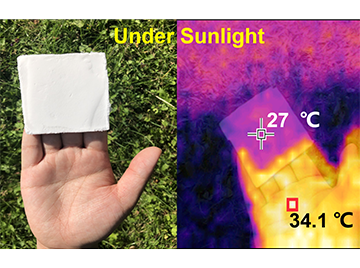FOR IMMEDIATE RELEASE | May 17, 2022
Keeping buildings cooler with a wood-based foam
“Dynamically Tunable All-Weather Daytime Cellulose Aerogel Radiative Supercooler for Energy-Saving Building”
Nano Letters
Summertime is almost here, a time when many people try to beat the heat. But running air conditioners constantly can be expensive and wasteful. Now, researchers reporting in ACS’ Nano Letters have designed a lightweight foam made from wood-based cellulose nanocrystals that reflects sunlight, emits absorbed heat and is thermally insulating. They suggest that the material could reduce buildings’ cooling energy needs by more than a third.
Although scientists have developed cooling materials, they have disadvantages. Some materials that passively release absorbed heat let a lot of heat through to buildings under the direct, midday sun of the summer months. And other materials that reflect sunlight don’t work well in hot, humid or cloudy weather. So, Yu Fu, Kai Zhang and colleagues wanted to develop a robust material that could reflect sunlight, passively release heat and keep wayward heat from passing through.
To generate a cooling material, the researchers connected cellulose nanocrystals together with a silane bridge, before freezing and freeze-drying the material under a vacuum. This process vertically aligned the nanocrystals, making a white, lightweight foam, which reflected 96% of visible light and emitted 92% of absorbed infrared radiation. When placed over an aluminum foil-lined box sitting outdoors at noon, the material kept the temperature inside the box 16 degrees F cooler than outside of it. Also, the material kept the inside of the box 13 degrees F cooler when the air was humid. As the cellulose-based foam was compressed, its cooling ability decreased, revealing tunable cooling properties. The team calculated that placing the foam on the roof and exterior walls of a building could reduce its cooling energy needs by an average of 35.4%. Because the wood-based cellulose foam’s performance can be tuned depending on weather conditions, the researcher say that the technology could be applied in a wide range of environments.
The authors acknowledge funding from the German Research Foundation (DFG), Lower Saxony Ministry of Science and Culture, the National Natural Science Foundation of China, Jiangsu Specially appointed Professorship Program, Science and Technology Innovation Project for Overseas Students of Nanjing City, the Postgraduate Research & Practice Innovation Program of Jiangsu Province, National First-class Disciplines (PNFD), the Jiangsu Government Scholarship for Overseas Studies and the China Scholarship Council.
To automatically receive press releases from the American Chemical Society, contact newsroom@acs.org.
Note: ACS does not conduct research, but publishes and publicizes peer-reviewed scientific studies.
Media Contact
ACS Newsroom
newsroom@acs.org

View larger image

